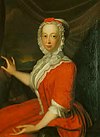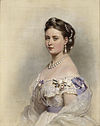Princess_Royal
Princess Royal
Noble title customarily awarded by a British monarch to his or her eldest daughter
Princess Royal is a style customarily (but not automatically) awarded by British monarchs to their eldest daughters. Although purely honorary, it is the highest honour that may be given to a female member of the royal family.[1] There have been seven Princesses Royal. Princess Anne became Princess Royal in 1987.[2]
The style Princess Royal came into existence when Queen Henrietta Maria (1609–1669), daughter of Henry IV, King of France, and wife of King Charles I (1600–1649), wanted to imitate the way the eldest daughter of the King of France was styled "Madame Royale".[3] Thus, Princess Mary (born 1631), the daughter of Henrietta Maria and Charles, became the first Princess Royal in 1642.
It has become established that the style belongs to no one by right, but is given entirely at the sovereign's discretion. Princess Mary (later Queen Mary II) (1662–1694), the eldest daughter of King James II, and Princess Sophia Dorothea (1687–1757), the only daughter of King George I, were eligible for this honour but did not receive it. At the time they respectively became eligible for the style, Princess Mary was already Princess of Orange, and Sophia Dorothea was already Queen in Prussia.[1] A Princess Royal has never acceded to the British throne; Princess Victoria, the eldest daughter of Queen Victoria, was the only Princess Royal to simultaneously be heir presumptive, until she was displaced by the birth of her brother Prince Albert Edward.
Princess Louisa Maria (1692–1712), the youngest daughter of King James II (died 1701), born after he lost his crown in the Glorious Revolution of 1688–1689, was considered to be Princess Royal during James's exile by Jacobites at Saint-Germain-en-Laye and was so called by them, even though she was not James's eldest living daughter at any time during her life.[3]
The title is held for life, even if the holder outlives her parent the monarch. On the death of a Princess Royal, the style is not inherited by any of her daughters; instead, if the monarch parent of the late Princess Royal has also died, the new monarch may bestow it upon his or her own eldest daughter. Thus, Princess Louise was granted the style of Princess Royal by her father King Edward VII in 1905; she retained it until her death in 1931, over twenty years into the reign of her brother King George V. Only upon Louise's death did the title become available for George's own daughter, Princess Mary, who was granted the title in 1932, retaining it until her death in 1965. Because Mary outlived not only her father but also her brother King George VI, the title was never available during George VI's reign to be granted to his elder daughter Princess Elizabeth (later Queen Elizabeth II), though she would otherwise have been eligible to hold it.[1] If Princess Anne dies during the reign of her brother King Charles III, then there would be no eligible royal princess; Charles III has no daughters and Princess Charlotte, the daughter of William, Prince of Wales, would only become eligible upon William's accession to the throne.
Customarily, when a princess marries, she takes on her husband's title. If her husband has a lower title or style, her style as a princess remains in use, although it may then be combined with her style by marriage, e.g. HRH The Princess Louise, Duchess of Argyll or HRH Princess Alice, Countess of Athlone – if that princess had a territorial designation, she may cease its use. Exceptionally, however, a princess who has been granted the title of HRH The Princess Royal will not customarily combine it with her style by marriage. For example, Princess Anne has been Her Royal Highness The Princess Royal since being given the title in 1987; prior to that, her formal title was Her Royal Highness The Princess Anne, Mrs Mark Phillips.[4]






